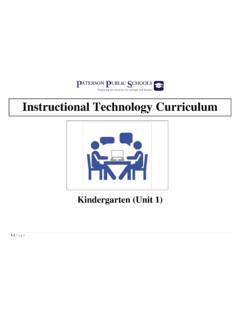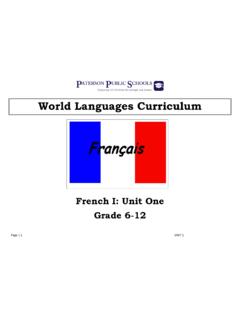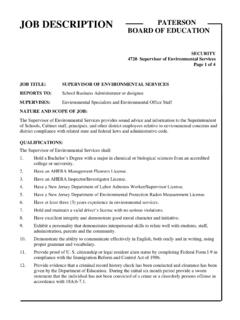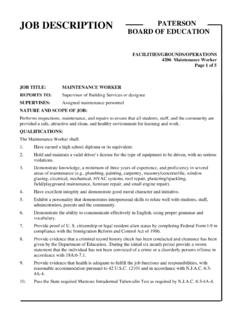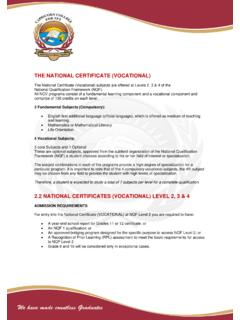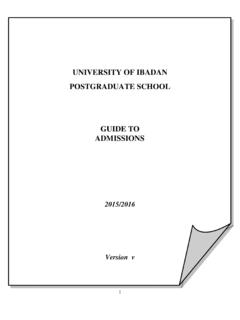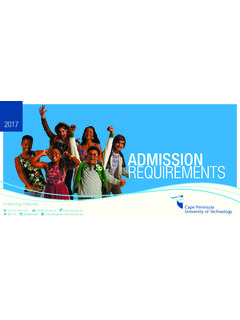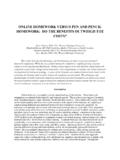Transcription of Yearbook Design and Publication Unit 4- Journalism and ...
1 1 ENGLISH LANGUAGE ARTS Yearbook Design and Publication unit 4- Journalism and Broadcasting 2 course Philosophy Yearbook Design and Publication consists of reading, writing, speaking, listening and media literacy skills. During instruction students will learn to use reading strategies that help them become effective readers. Some of these strategies include questioning the author, inferring, visualizing, synthesizing and learning multiple strategies to help students learn to monitor their reading comprehension. The media literacy skills will educate students in creating a variety of graphic designs as well as an emphasis on terminology. The Yearbook Design and Publication course is designed to provide an opportunity for students to learn about the publishing process by designing, building and marketing. Students will work on developing skills in: graphics, desktop publishing, computer Design , photography, and marketing.
2 They will be challenged to graphically capture important moments in the school year. They will research, organize, and verify information for accuracy and relevancy. They will develop creative ideas to present this information, and organize their work to meet deadlines. They will also market their Publication in the school and in the larger community. The course is planned around universal themes and essential questions to encourage students to engage in deep meaningful discussions to socialize intelligence. The workshop model is employed so that all students can improve their skills and voice as writers. The teachers are trained and will instruct students using the workshop model philosophy with the use of the I DO, WE DO, YOU DO method of instruction. The Standards are designed to provide a clear understanding of what students are expected to learn, so teachers and parents know what they need to do to help them.
3 The standards are designed to be robust and relevant to the real world, reflecting the knowledge and skills that our young learners need for success in college and careers. It is our goal to establish a community of learners to become productive citizens in society striving towards pursuing their life-long goals. Through an enriching and rigorous education and with on-going support our students will be fully prepared for the future and compete successfully in the global economy. 3 Methods of Instruction Teacher Coaching Individual and collaborative problem-solving & decision-making Individual Instruction Small group instruction Peer tutoring Guest Speakers Training manuals and Online tutorials Writing to learn Making thinking visible Note-taking Establishing metacognitive reflection & articulation as a regular pattern in learning Diagrams, charts, visuals and graphs Model (I Do), Guided Practice (We Do), Independent Practice (You Do) Pacing Chart unit 4 YouTube videos pretty good-shows a bad interview and then a good one.
4 The interviewer does the exact same both times. 7 minutes How to answer the question "Tell me about yourself" The interviewee makes the mistakes with suggestions written for improvement. 1 minute 4 minutes Dos and Don't of interviews: How to dress, proper handshake, Key questions and how to answer them, Key suggestions GOOD Interview Question Tips Common questions and how to answer them. 8 weeks - List of interview questions often asked and ones that applicants can ask. - Manual on Imovie: Youtube tutorial on Imovie Educational Technology Standards , , , , , , , , Technology Operations and Concepts Create a personal digital portfolio which reflects personal and academic interests, achievements, and career aspirations by using a variety of digital tools and resources Produce and edit a multi-page digital document for a commercial or professional audience and present it to peers and/or professionals in that related area for review.
5 Creativity and Innovation Apply previous content knowledge by creating and piloting a digital learning game or tutorial. Communication and Collaboration Develop an innovative solution to a real world problem or issue in collaboration with peers and experts, and present ideas for feedback through social media or in an online community. Digital Citizenship Demonstrate appropriate application of copyright, fair use and/or Creative Commons to an original work. Evaluate consequences of unauthorized electronic access and disclosure, and on dissemination of personal information. Compare and contrast policies on filtering and censorship both locally and globally. Research and Information literacy Produce a position statement about a real world problem by developing a systematic plan of investigation with peers and experts synthesizing information from multiple sources. Critical Thinking, Problem Solving, Decision Making Evaluate the strengths and limitations of emerging technologies and their impact on educational, career, personal and or social needs.
6 Career Ready Practices Career Ready Practices describe the career-ready skills that all educators in all content areas should seek to develop in their students. They are practices that have been linked to increase college, career, and life success. Career Ready Practices should be taught and reinforced in all career exploration and preparation programs with increasingly higher levels of complexity and expectation as a student advances through a program of study. CRP1. Act as a responsible and contributing citizen and employee Career-ready individuals understand the obligations and responsibilities of being a member of a community, and they demonstrate this understanding every day through their interactions with others. They are conscientious of the impacts of their decisions on others and the environment around them. They think about the near-term and long-term consequences of their actions and seek to act in ways that contribute to the betterment of their teams, families, community and workplace.
7 They are reliable and consistent in going beyond the minimum expectation and in participating in activities that serve the greater good. CRP2. Apply appropriate academic and technical skills. Career-ready individuals readily access and use the knowledge and skills acquired through experience and education to be more productive. They make connections between abstract concepts with real-world applications, and they make correct insights about when it is appropriate to apply the use of an academic skill in a workplace situation CRP3. Attend to personal health and financial well-being. Career-ready individuals understand the relationship between personal health, workplace performance and personal well-being; they act on that understanding to regularly practice healthy diet, exercise and mental health activities. Career-ready individuals also take regular action to contribute to their personal financial wellbeing, understanding that personal financial security provides the peace of mind required to contribute more fully to their own career success.
8 Career Ready Practices CRP4. Communicate clearly and effectively and with reason. Career-ready individuals communicate thoughts, ideas, and action plans with clarity, whether using written, verbal, and/or visual methods. They communicate in the workplace with clarity and purpose to make maximum use of their own and others time. They are excellent writers; they master conventions, word choice, and organization, and use effective tone and presentation skills to articulate ideas. They are skilled at interacting with others; they are active listeners and speak clearly and with purpose. Career-ready individuals think about the audience for their communication and prepare accordingly to ensure the desired outcome. CRP5. Consider the environmental, social and economic impacts of decisions. Career-ready individuals understand the interrelated nature of their actions and regularly make decisions that positively impact and/or mitigate negative impact on other people, organization, and the environment.
9 They are aware of and utilize new technologies, understandings, procedures, materials, and regulations affecting the nature of their work as it relates to the impact on the social condition, the environment and the profitability of the organization. CRP6. Demonstrate creativity and innovation. Career-ready individuals regularly think of ideas that solve problems in new and different ways, and they contribute those ideas in a useful and productive manner to improve their organization. They can consider unconventional ideas and suggestions as solutions to issues, tasks or problems, and they discern which ideas and suggestions will add greatest value. They seek new methods, practices, and ideas from a variety of sources and seek to apply those ideas to their own workplace. They take action on their ideas and understand how to bring innovation to an organization. CRP7. Employ valid and reliable research strategies.
10 Career-ready individuals are discerning in accepting and using new information to make decisions, change practices or inform strategies. They use reliable research process to search for new information. They evaluate the validity of sources when considering the use and adoption of external information or practices in their workplace situation. Career Ready Practices CRP8. Utilize critical thinking to make sense of problems and persevere in solving them. Career-ready individuals readily recognize problems in the workplace, understand the nature of the problem, and devise effective plans to solve the problem. They are aware of problems when they occur and take action quickly to address the problem; they thoughtfully investigate the root cause of the problem prior to introducing solutions. They carefully consider the options to solve the problem. Once a solution is agreed upon, they follow through to ensure the problem is solved, whether through their own actions or the actions of others.

